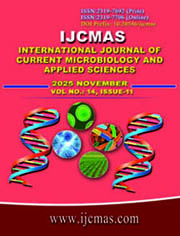


 National Academy of Agricultural Sciences (NAAS)
National Academy of Agricultural Sciences (NAAS)

|
PRINT ISSN : 2319-7692
Online ISSN : 2319-7706 Issues : 12 per year Publisher : Excellent Publishers Email : editorijcmas@gmail.com / submit@ijcmas.com Editor-in-chief: Dr.M.Prakash Index Copernicus ICV 2018: 95.39 NAAS RATING 2020: 5.38 |
Aspergillus aflatoxiformans was isolated from the rhizosphere soil of Madhubani, Bihar, India, and identified through ITS sequencing and phylogenetic analysis (GenBank accession number: PV789347). Antagonistic activity against Mucor irregularis (GenBank accession no. PV789341) was evaluated on potato dextrose agar (PDA) using the dual culture technique, which showed a mean percentage inhibition of radial growth (PIRG) of 80. 9 ± 4. 08%. Chitinase activity was quantified by measuring the hydrolysis zone diameter in six replicate plates, with a mean value of 2. 99 ± 0. 21 cm and a coefficient of variation of 7. 12%. Protease activity showed a mean proteolytic zone diameter of 3. 34 ± 0. 37 cm (n = 9). For plant interaction assessment, a 5-day-old broth culture containing approximately 1 × 10? spores mL?¹ was prepared and 10 ml volume applied as a foliar and root spray to Tagetes erecta (marigold) every 15 days during evening time. No significant differences were observed in treated plants compared to controls, indicating the absence of phytotoxic effects. These findings highlight A. aflatoxiformis from Madhubani as a potentially safe and enzymatically active antagonist against plant pathogens, supporting its further exploration as a biocontrol agent in sustainable agriculture.
Amaike, S. and Keller, N.P., 2011. Aspergillus flavus. Annual Review of Phytopathology, 49, pp.107–133. https://doi.org/10.1146/annurev-phyto-072910-095221
Jung, K.S., Kim, H.M., Lee, J., Ganbat, D. and Lee, S.E., 2024. Biocontrol of aflatoxin-producing Aspergillus flavus ATCC 22546 by a non-aflatoxigenic Aspergillus flavus ATCC 9643. Applied Sciences, 14(14), p.6142. https://doi.org/10.3390/app1414612
Karthikeyan, V., Sankaralingam, S. and Kalaiselvi, N., 2020. Evaluation of non-aflatoxigenic Aspergillus flavus as biocontrol agents against toxigenic strains in groundnut. Biological Control, 147, p.104289. https://doi.org/10.1016/j.biocontrol.2020.104289
Klich, M.A. and Pitt, J.I., 2012. Differentiation of Aspergillus flavus from A. parasiticus and other closely related species. International Journal of Food Microbiology, 156(3), pp.236–241. https://doi.org/10.1016/j.ijfoodmicro.2012.04.015
Kumar, S., Stecher, G., Li, M., Knyaz, C. and Tamura, K., 2018. MEGA X: Molecular evolutionary genetics analysis across computing platforms. Molecular Biology and Evolution, 35(6), pp.1547–1549. https://doi.org/10.1093/molbev/msy096
Meena, M., Gupta, S.K., Swapnil, P., Zehra, A., Dubey, M.K. and Upadhyay, R.S., 2017. Alternaria toxins: Potential virulence factors and genes related to pathogenesis. Frontiers in Microbiology, 8, p.1451. https://doi.org/10.3389/fmicb.2017.01451
Monreal, J. and Reese, E.T., 1969. The chitinase of Serratia marcescens. Canadian Journal of Microbiology, 15(6), pp.689–696. https://doi.org/10.1139/m69-123
Nawani, N.N. and Kapadnis, B.P., 2001. Chitinase production by Streptomyces sp. NK1057. Brazilian Journal of Microbiology, 32(4), pp.295–297. https://doi.org/10.1590/S1517-83822001000400003
Ornela, P.H. and Guimarães, L.H.S., 2024. Purification, characterization and antifungal activity of the Aspergillus niveus chitinase produced using shrimp shells. Applied Biosciences, 3(2), pp.220–232.
Ortega-Beltran, A. and Bandyopadhyay, R., 2023. Aflatoxin biocontrol in practice requires a multidisciplinary, long-term approach. Frontiers in Sustainable Food Systems, 7, p.1110964. https://doi.org/10.3389/fsufs.2023.1110964
Ortega-Beltran, A., Aikore, M.S., Kaptoge, L., Agbetiameh, D., Moral, J. and Bandyopadhyay, R., 2024. Impact of storage conditions on the shelf life of aflatoxin biocontrol products containing atoxigenic isolates of Aspergillus flavus as active ingredient applied in various countries in Africa. CABI Agriculture and Bioscience, 5(1), p.78. https://doi.org/10.1186/s43170-024-00178-7
Pal, K.K. and Gardener, B.M., 2006. Biological control of plant pathogens. The Plant Health Instructor. https://doi.org/10.1094/PHI-A-2006-1117-02
Skidmore, A.M. and Dickinson, C.H., 1976. Colony interactions and hyphal interference between Septoria nodorum and phylloplane fungi. Transactions of the British Mycological Society, 66(1), pp.57–64. https://doi.org/10.1016/S0007-1536(76)80008-5
Verma, R.K., Kharwar, R.N. and Singh, R.P., 2021. Enzymatic and antifungal potential of Aspergillus niger against soil-borne pathogens. Archives of Phytopathology and Plant Protection, 54(1–2), pp.1–12. https://doi.org/10.1080/03235408.2020.1865791
Vishwanatha, K.S., Rao, A.G.A. and Singh, S.A., 2009. Acid protease production by solid-state fermentation using Aspergillus oryzae MTCC 5341: Optimization of process parameters. Journal of Industrial Microbiology & Biotechnology, 36, pp.129–139. https://doi.org/10.1007/s10295-008-0485-5
Wang, S., Wang, Y., Shi, X., Herrera-Balandrano, D.D., Chen, X., Liu, F. and Laborda, P., 2024. Application and antagonistic mechanisms of atoxigenic Aspergillus strains for the management of fungal plant diseases. Applied and Environmental Microbiology, 90(10), p.e01085-24. https://doi.org/10.1128/aem.01085-24 |
 |
 |
 |
 |